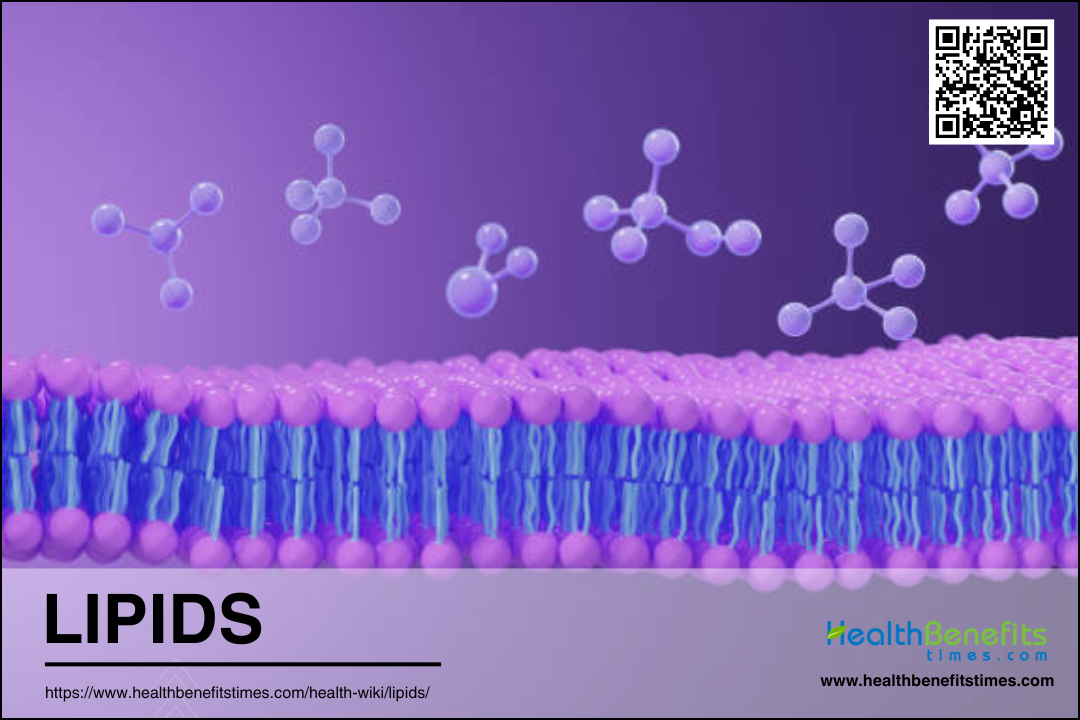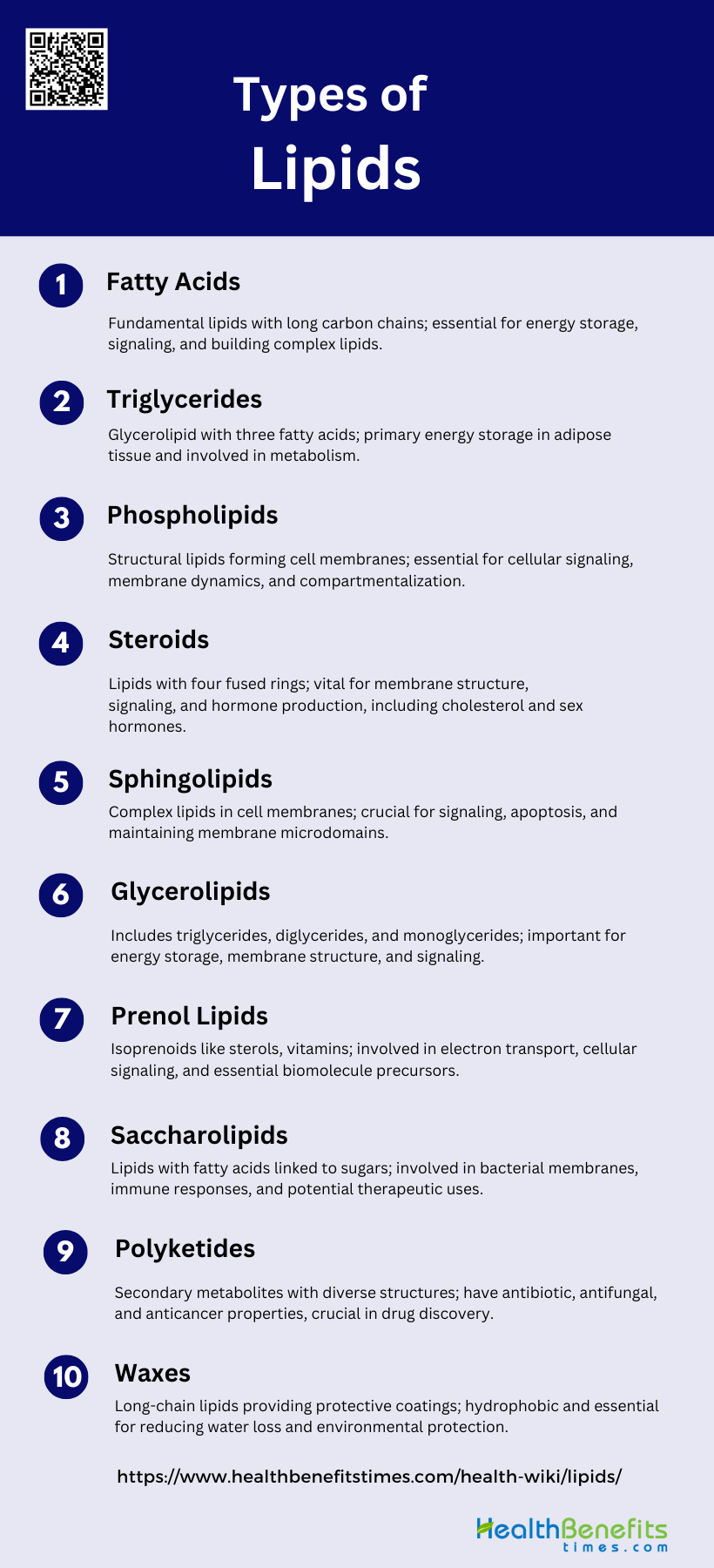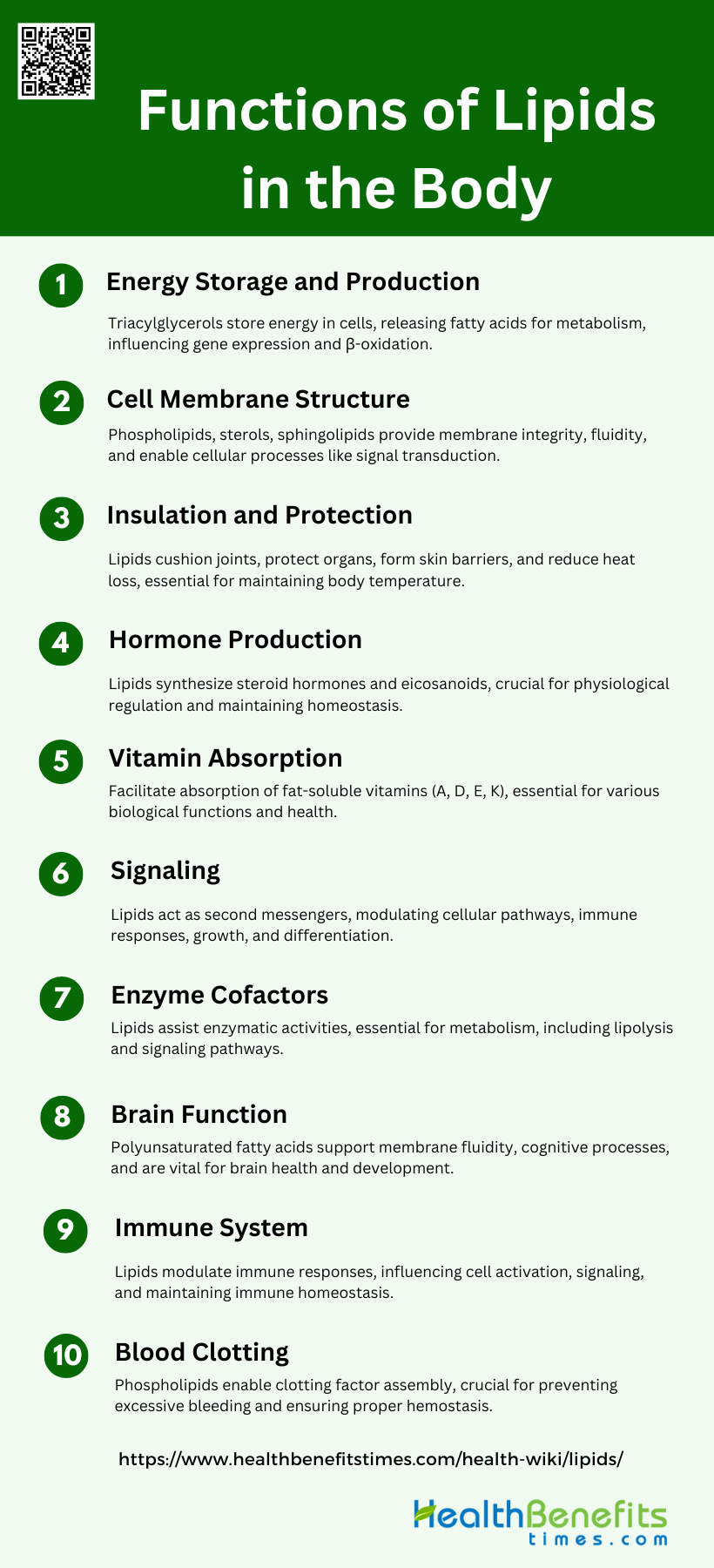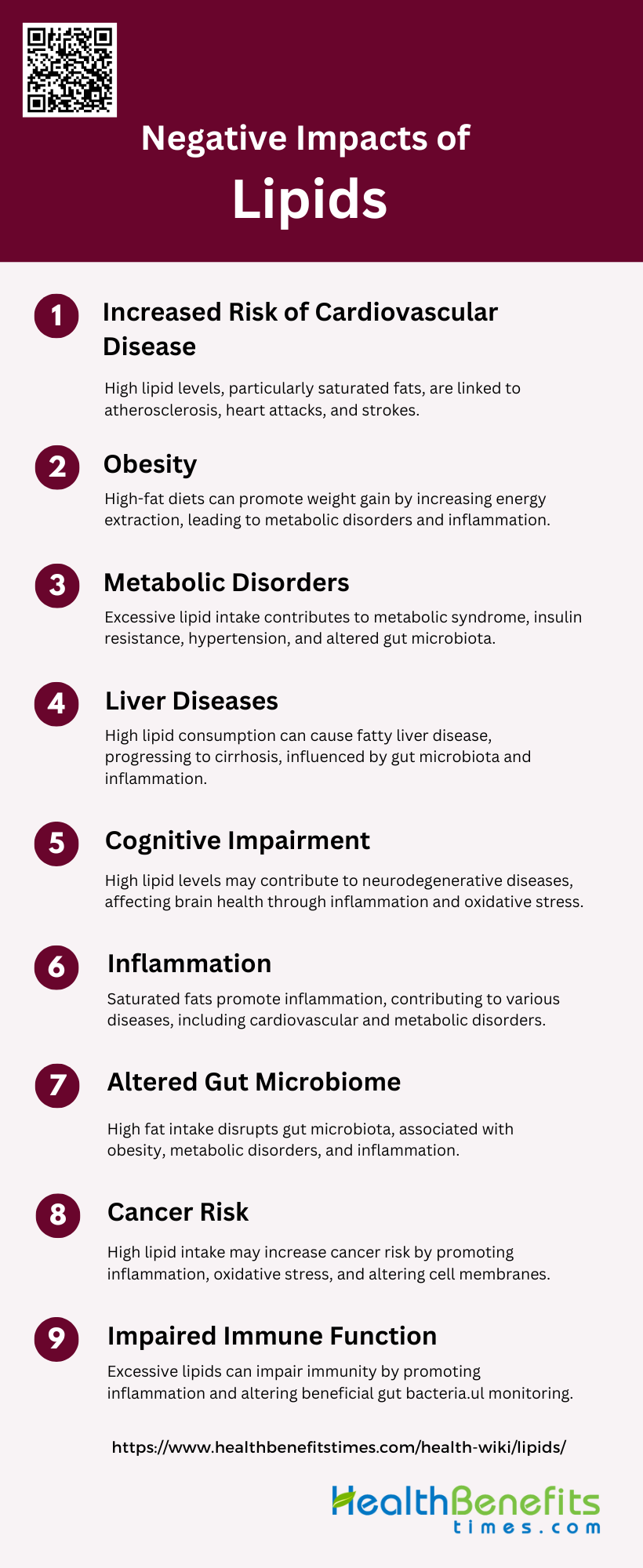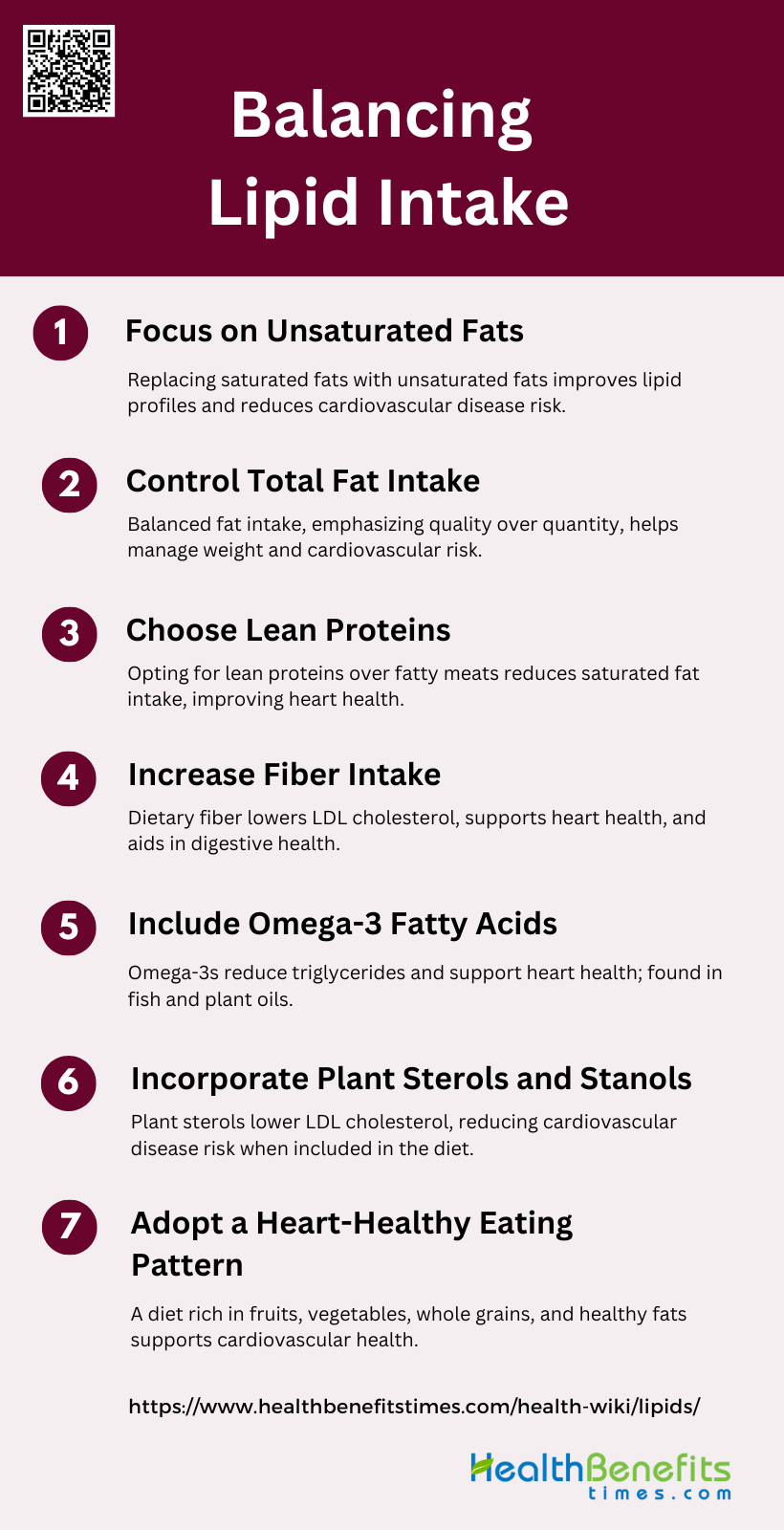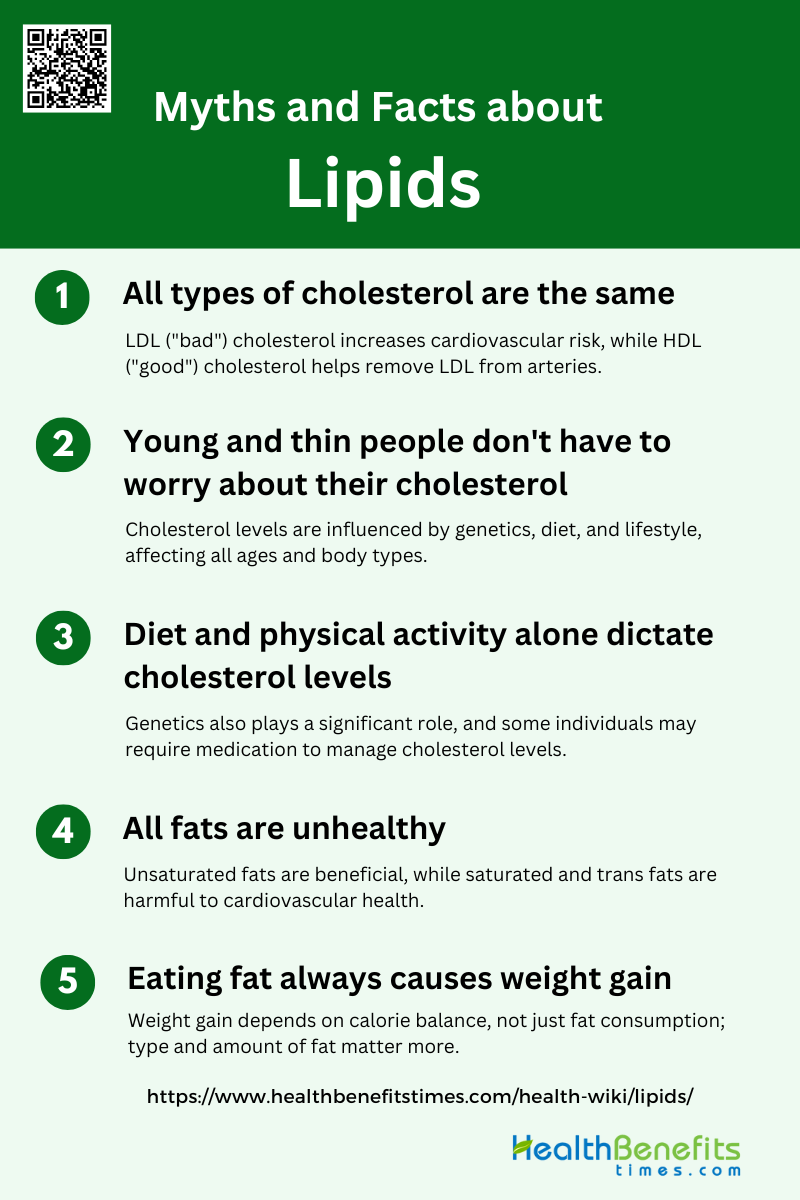Lipids are a diverse group of organic compounds that are insoluble in water but soluble in organic solvents. They play crucial roles in biological systems, serving as major structural components of cell membranes, energy storage molecules, and signaling molecules. Lipids include fats, oils, waxes, phospholipids, and steroids. Structurally, they are characterized by their hydrophobic nature, which allows them to form the bilayer of cell membranes, providing a barrier and matrix for cellular processes. Additionally, lipids are involved in various biological functions, such as energy storage, insulation, and cellular communication. Their roles in health and disease are significant, as they are involved in metabolic processes and can influence inflammation and other cellular functions.
Types of Lipids
Lipids are a diverse group of hydrophobic molecules that play essential roles in biological systems, including energy storage, cell membrane structure, and signaling. They can be classified into various types based on their chemical structure and function. Below are the main types of lipids, each with unique characteristics and functions:
1. Fatty Acids
Fatty acids are fundamental biological lipids characterized by long chains of carbon atoms that impart distinctive hydrophobic properties. They typically terminate in a carboxyl, aldehyde, or alcohol group, allowing them to form ester, ether, or amide bonds with various compounds, including proteins and complex carbohydrates. Fatty acids are crucial for energy storage and serve as building blocks for more complex lipids. They are also involved in signaling processes and can be classified based on the length of their aliphatic chain into short-, medium-, and long-chain fatty acids, each with distinct biological activities and therapeutic relevance.
2. Triglycerides
Triglycerides, also known as triacylglycerides, are a type of glycerolipid composed of one glycerol molecule esterified to three fatty acid chains. They are primarily used for energy storage in adipose tissues and are a major component of dietary fats. In the chicken epidermis, triglycerides contain some very long-chain saturated fatty acids, which may have significance in human health. Triglycerides are also involved in metabolic processes and can be broken down to release fatty acids and glycerol, which are then utilized for energy production.
3. Phospholipids
Phospholipids are a major class of lipids that form the structural basis of biological membranes. They consist of a glycerol backbone, two fatty acid tails, and a phosphate group attached to a polar head group. The major phospholipids include phosphatidylcholine, phosphatidylethanolamine, and sphingomyelin. Phospholipids play key roles in cellular signaling and membrane dynamics. Due to their amphipathic nature, they are essential for the formation of lipid bilayers, which compartmentalize cellular processes and mediate interactions with the extracellular environment.
4. Steroids
Steroids are a class of lipids characterized by a core structure of four fused carbon rings. They include sterols, such as cholesterol, and hormones like testosterone and estrogen. Steroids play various roles in cellular processes, including membrane structure stabilization and signaling. They are also precursors for bile acids, which aid in digestion, and secosteroids like vitamin D, which are crucial for calcium homeostasis. The diverse functions of steroids make them integral to both structural and regulatory aspects of cellular physiology.
5. Sphingolipids
Sphingolipids are a complex class of lipids that include ceramides, sphingomyelins, and glycosphingolipids. They are essential components of the plasma membrane and play significant roles in cell signaling and apoptosis. Sphingolipids are involved in the formation of lipid rafts, which are specialized membrane microdomains that facilitate signal transduction. In the chicken epidermis, sphingolipids include ceramides and glucosylceramides, which contribute to the epidermal water barrier. Their unique structure and function make sphingolipids critical for maintaining cellular integrity and communication.
6. Glycerolipids
Glycerolipids are a diverse group of lipids that include triglycerides, diglycerides, and monoglycerides. They are composed of a glycerol backbone esterified to one, two, or three fatty acid chains. Glycerolipids play crucial roles in energy storage, membrane structure, and signaling. In pathological environments, such as cancer, glycerolipids are regarded as potential therapeutic targets due to their involvement in metabolic disorders. The versatility of glycerolipids in various biological processes underscores their importance in cellular physiology and pathology.
7. Prenol Lipids
Prenol lipids, also known as isoprenoids or terpenoids, are constructed from five-carbon isoprene units. This group includes sterols, steroids, quinones, and vitamins like A, E, and K. Prenol lipids are involved in various biological functions, including electron transport, cellular signaling, and membrane structure. They are also precursors for essential biomolecules such as coenzyme Q and carotenoids. The diverse roles of prenol lipids in cellular processes highlight their significance in maintaining cellular homeostasis and function.
8. Saccharolipids
Saccharolipids are a unique class of lipids where fatty acids are linked directly to a sugar backbone, forming structures like lipopolysaccharides and glycolipids. They are primarily found in bacterial membranes and play roles in immune system activation and endotoxin effects. Chemically modified saccharolipids have potential therapeutic applications, such as cancer immunotherapy and vaccine adjuvants. Their ability to stimulate the immune system makes saccharolipids valuable in biomedical research and therapeutic development.
9. Polyketides
Polyketides are a diverse group of secondary metabolites derived from poly-β-ketoacid chains. They are often found in macrolide, aromatic, and polycyclic structures and have various biological activities, including antibiotic, antifungal, and anticancer properties. Polyketides are synthesized through the condensation of acetate units and are known for their complex chemical structures and potent bioactivities. Their role in natural product chemistry and drug discovery underscores their importance in pharmaceutical research.
10. Waxes
Waxes are a class of lipids composed of long-chain fatty acids esterified to long-chain alcohols. They are hydrophobic and serve as protective coatings on plant leaves, animal skin, and feathers, preventing water loss and providing a barrier against environmental stress. In the chicken epidermis, wax diesters contain saturated fatty acids esterified to long-chain diols, which may have significance in human health. The protective properties of waxes make them essential for maintaining the integrity and function of biological surfaces.
Dietary Sources of Lipids
List of Foods Rich in Healthy Lipids
Foods rich in healthy lipids include sources of polyunsaturated fatty acids (PUFAs), monounsaturated fatty acids (MUFAs), and other bioactive lipids. Examples of such foods are fatty fish like salmon and mackerel, which are high in omega-3 fatty acids (EPA and DHA) known for their anti-inflammatory properties and cardiovascular benefits. Nuts and seeds, such as almonds, walnuts, and flaxseeds, are excellent sources of MUFAs and PUFAs, contributing to improved lipid metabolism and reduced cardiovascular disease risk. Additionally, plant oils like olive oil and avocado oil are rich in MUFAs, which have been shown to lower LDL cholesterol and improve overall lipid profiles. These foods not only provide essential fatty acids but also contain other beneficial compounds like phytosterols and fat-soluble vitamins that support overall health.
Discussion on Sources of Unhealthy Lipids
Unhealthy lipids are primarily found in foods high in saturated fatty acids (SFAs) and trans fats. Red and processed meats, such as beef, pork, and sausages, are significant sources of SFAs, which have been linked to increased LDL cholesterol levels and a higher risk of cardiovascular disease. Dairy products like butter, cheese, and cream also contain high levels of SFAs, contributing to adverse lipid profiles. Additionally, many commercially baked goods, fried foods, and margarine contain trans fats, which not only raise LDL cholesterol but also lower HDL cholesterol, further exacerbating cardiovascular risk. The consumption of these unhealthy lipids should be minimized to maintain a healthy lipid profile and reduce the risk of chronic diseases.
Functions of Lipids in the Body
Lipids are vital to numerous physiological processes, serving as key components of cell membranes, energy storage molecules, and signaling molecules. They also play roles in insulation, protection, and hormone production. Below are the primary functions of lipids in the body:
1. Energy Storage and Production
Lipids, particularly triacylglycerols (TAGs), are the primary units of energy storage in eukaryotic cells. TAGs are stored in white adipocytes, enterocytes, hepatocytes, and mammary epithelial cells, where they play crucial roles in energy storage and production. TAGs sequester essential fatty acids (FAs) and precursors of eicosanoids, protecting cells from the potential detergent-like properties of FAs or their acyl-CoA derivatives, which may injure cellular membranes. Cellular stores of TAGs in lipid droplets release FAs that are channeled selectively to β-oxidation, influencing the transcriptional control of gene expression.
2. Cell Membrane Structure
Lipids are fundamental components of cell membranes, providing structural integrity and fluidity. Phospholipids, sterols, and sphingolipids are the major structural lipids in biological membranes. These lipids form bilayers that define cell and organelle boundaries, enabling compartmentalization and the formation of specialized membrane domains. The dynamic regulation of lipid composition in membranes is essential for various cellular processes, including signal transduction, membrane trafficking, and cell-cell communication.
3. Insulation and Protection
Lipids serve as insulators and protectors within the body. TAGs act as mechanical cushions within joints and around internal organs, providing physical protection. Additionally, lipids contribute to the formation of the water barrier of the skin, which is essential for preventing dehydration and protecting against external environmental factors. The insulating properties of lipids are also crucial for maintaining body temperature by reducing heat loss.
4. Hormone Production
Lipids are precursors for the synthesis of various hormones, including steroid hormones and eicosanoids. Sterols, such as cholesterol, are converted into steroid hormones like cortisol, estrogen, and testosterone, which regulate numerous physiological processes. Eicosanoids, derived from polyunsaturated fatty acids (PUFAs), play roles in inflammation, immunity, and other signaling pathways. The synthesis and regulation of these lipid-derived hormones are critical for maintaining homeostasis and responding to physiological changes.
5. Vitamin Absorption
Lipids facilitate the absorption of fat-soluble vitamins (A, D, E, and K) in the digestive system. These vitamins are essential for various biological functions, including vision, bone health, antioxidant activity, and blood clotting. Lipids in the diet form micelles that solubilize these vitamins, allowing their absorption in the intestines. Without adequate lipid intake, the absorption and bioavailability of these essential vitamins would be significantly impaired.
6. Signaling
Lipids play crucial roles in cellular signaling. They can act as second messengers, modulating signal transduction pathways. For example, phosphoinositides like PIP3 are involved in T cell receptor signaling, while diacylglycerol (DAG) and phosphatidic acid (PA) regulate Ras activation in T cells. Lipid signaling is essential for various cellular processes, including immune responses, cell growth, and differentiation. Lipid-modifying enzymes and lipid-binding proteins are potential therapeutic targets for immune disorders and other diseases.
7. Enzyme Cofactors
Certain lipids function as enzyme cofactors, essential for the catalytic activity of specific enzymes. For instance, phospholipids are required for the activity of lipolytic enzymes involved in triacylglycerols metabolism. Additionally, lipids like cholesterol serve as precursors or cofactors for signaling molecules, influencing various metabolic pathways. The interaction between lipids and enzymes is crucial for maintaining cellular metabolism and homeostasis.
8. Brain Function
Lipids, particularly polyunsaturated fatty acids (PUFAs), are vital for brain function. They are involved in the regulation of membrane fluidity, axonal growth, development, memory, and inflammatory responses. PUFAs like arachidonic acid and docosahexaenoic acid are enriched in the central nervous system and play roles in neural signaling and cognitive processes. Alterations in lipid metabolism and signaling are associated with neurodevelopmental and neurodegenerative diseases.
9. Immune System
Lipids are integral to the immune system, influencing both innate and adaptive immune responses. Phospholipids and their metabolic products regulate various aspects of immune cell biology, including shape change, aggregation, and degranulation. Lipids also act as signaling molecules, modulating immune cell activation and function. For example, phosphoinositides and eicosanoids play roles in T cell signaling and inflammation. Lipid metabolism is crucial for mounting effective immune responses and maintaining immune homeostasis.
10. Blood Clotting
Lipids are essential for blood clotting, a critical process for preventing excessive bleeding. Phospholipids, particularly those in platelet membranes, provide a surface for the assembly of clotting factors, facilitating the formation of a blood clot. Additionally, certain lipids act as cofactors for enzymes involved in the coagulation cascade. The dynamic regulation of lipid composition in platelets and other cells is crucial for proper hemostasis and preventing thrombotic disorders.
Negative impacts of lipids
While lipids are essential for various bodily functions, excessive intake or imbalances can lead to health issues. High levels of certain lipids are linked to cardiovascular diseases, obesity, and metabolic disorders. Below are the negative impacts of lipids on health:
1. Increased Risk of Cardiovascular Disease
High lipid levels, particularly saturated fats, are strongly associated with an increased risk of cardiovascular disease (CVD). Elevated lipids contribute to the formation of atherosclerotic plaques, which can obstruct blood flow and lead to heart attacks and strokes. Studies have shown that dietary fatty acids, especially n-3 polyunsaturated fatty acids, can influence the bioactive lipid profile and reduce inflammation markers like Lp-PLA2, which are linked to CVD risk. Additionally, obesity, often driven by high lipid intake, exacerbates cardiovascular risk by promoting insulin resistance, dyslipidemia, and inflammation.
2. Obesity
Lipids play a significant role in the development of obesity. High-fat diets can lead to excessive weight gain by increasing the efficiency of energy harvest from food and promoting fat accumulation. The gut microbiota of obese individuals is often characterized by a higher ratio of Firmicutes to Bacteroidetes, which enhances energy extraction from the diet. Obesity is also associated with metabolic endotoxemia, where lipopolysaccharides (LPS) from gut bacteria enter the bloodstream, causing low-grade inflammation and insulin resistance.
3. Metabolic Disorders
Excessive lipid intake is a major contributor to metabolic disorders such as metabolic syndrome, which includes conditions like insulin resistance, hypertension, and dyslipidemia. High-fat diets can alter gut microbiota composition, leading to increased production of harmful metabolites like p-cresol and indole, which are linked to metabolic disorders. Prebiotics like galactooligosaccharides have been shown to improve gut microbiota composition and reduce markers of metabolic syndrome, including blood lipids and inflammation.
4. Liver Diseases
High lipid consumption can lead to non-alcoholic fatty liver disease (NAFLD), characterized by excessive fat accumulation in the liver. This condition can progress to non-alcoholic steatohepatitis (NASH), fibrosis, and cirrhosis. The gut microbiota plays a crucial role in this process by influencing lipid metabolism and promoting systemic exposure to LPS, which triggers inflammation and liver damage. Studies have shown that dietary interventions, such as milk polar lipids, can reduce intestinal cholesterol absorption and improve liver health.
5. Cognitive Impairment
Emerging evidence suggests that high lipid levels may contribute to cognitive impairment and neurodegenerative diseases. Lipids can influence brain function through various mechanisms, including the modulation of inflammation and oxidative stress. High-fat diets have been linked to increased oxidative stress and altered gut microbiota, which can affect brain health. Additionally, chronic inflammation driven by high lipid intake can impair cognitive function and increase the risk of conditions like Alzheimer’s disease.
6. Inflammation
Lipids, particularly saturated fats, are known to promote inflammation. High-fat diets can increase the levels of pro-inflammatory molecules like LPS, which activate the innate immune system and trigger a cascade of inflammatory responses. This chronic low-grade inflammation is a key factor in the development of various diseases, including CVD, obesity, and metabolic disorders. Reducing saturated fat intake and increasing the consumption of anti-inflammatory nutrients can help mitigate these effects.
7. Altered Gut Microbiome
High lipid intake can significantly alter the gut microbiome, leading to dysbiosis. Diets rich in fats, especially saturated and trans fats, can decrease the diversity of gut bacteria and increase the abundance of harmful species like Alistipes and Bacteroides. This dysbiosis is associated with various health issues, including obesity, metabolic disorders, and inflammation. Prebiotics and dietary modifications can help restore a healthy gut microbiome and improve overall health.
8. Cancer Risk
There is evidence to suggest that high lipid intake may increase the risk of certain cancers. Lipids can influence cancer development through various mechanisms, including the promotion of inflammation, oxidative stress, and alterations in cell membrane composition. High-fat diets have been linked to an increased risk of colorectal cancer, possibly due to changes in gut microbiota and the production of carcinogenic metabolites. Reducing fat intake and maintaining a balanced diet can help lower cancer risk.
9. Impaired Immune Function
Excessive lipid consumption can impair immune function by promoting inflammation and altering gut microbiota. High-fat diets can increase the levels of pro-inflammatory cytokines and reduce the abundance of beneficial gut bacteria, which play a crucial role in maintaining immune homeostasis. This dysregulation can weaken the immune response and increase susceptibility to infections and chronic diseases. Dietary interventions that promote a healthy gut microbiome can help enhance immune function and reduce inflammation.
Balancing Lipid Intake
Maintaining a balanced lipid intake is crucial for overall health and well-being. It involves making informed dietary choices to ensure the right types and amounts of fats are consumed. Below are key strategies to help balance lipid intake effectively:
1. Focus on Unsaturated Fats
Unsaturated fats, particularly polyunsaturated and monounsaturated fats, are beneficial for cardiovascular health. Replacing saturated fats with unsaturated fats can improve lipid profiles and reduce the risk of coronary heart disease (CHD). Studies have shown that substituting saturated fats with polyunsaturated fats can lower low-density lipoprotein (LDL) cholesterol levels, which is a key factor in reducing cardiovascular disease risk. Additionally, omega-3 fatty acids, a type of polyunsaturated fat found in fish and some plant oils, have been associated with a reduction in triglycerides and a slight decrease in the risk of coronary heart disease events.
2. Control Total Fat Intake
Controlling total fat intake is crucial for maintaining a healthy weight and reducing the risk of cardiovascular diseases. Excessive fat intake, particularly from unhealthy sources, can lead to obesity and related health issues. Research indicates that a diet with balanced fat intake, emphasizing the quality of fats rather than the quantity, is more effective in managing lipid levels and reducing cardiovascular risk. For instance, replacing high-fat foods with those rich in unsaturated fats and fiber can help manage weight and improve lipid profiles, thereby lowering the risk of heart disease.
3. Choose Lean Proteins
Choosing lean proteins, such as poultry, fish, beans, and legumes, over fatty meats can significantly impact cardiovascular health. Lean proteins provide essential nutrients without the high levels of saturated fats found in red and processed meats. Studies suggest that incorporating lean proteins into the diet can help lower LDL cholesterol levels and reduce the risk of cardiovascular diseases. Additionally, fish, which is a source of lean protein, provides omega-3 fatty acids that have been shown to reduce triglycerides and potentially lower the risk of coronary heart disease events.
4. Increase Fiber Intake
Increasing fiber intake is beneficial for cardiovascular health and overall well-being. Dietary fiber, particularly soluble fiber, can help lower LDL cholesterol levels and improve heart health. Research has shown that high-fiber diets are associated with a lower prevalence of cardiovascular disease and can reduce LDL cholesterol by 5-10%. Foods rich in fiber, such as whole grains, fruits, vegetables, and legumes, not only aid in cholesterol management but also promote digestive health and help maintain a healthy weight.
5. Include Omega-3 Fatty Acids
Omega-3 fatty acids, found in oily fish and some plant sources, play a crucial role in cardiovascular health. These fatty acids, including eicosapentaenoic acid (EPA) and docosahexaenoic acid (DHA), have been shown to reduce triglycerides and may slightly reduce the risk of coronary heart disease events. While the overall impact on all-cause mortality and cardiovascular events is modest, the inclusion of omega-3-rich foods in the diet is recommended for their potential benefits in reducing triglycerides and supporting heart health.
6. Incorporate Plant Sterols and Stanols
Plant sterols and stanols are effective in lowering LDL cholesterol levels, which can help reduce the risk of cardiovascular diseases. These compounds, found in fortified foods and supplements, work by blocking the absorption of cholesterol in the intestines. Studies have demonstrated that consuming 2 grams per day of plant sterols or stanols can lower LDL cholesterol by about 10%. Incorporating these into a cholesterol-lowering diet can be a beneficial strategy for managing lipid levels and improving heart health.
7. Adopt a Heart-Healthy Eating Pattern
Adopting a heart-healthy eating pattern involves a balanced diet rich in fruits, vegetables, whole grains, lean proteins, and healthy fats. This approach not only helps in managing cholesterol levels but also supports overall cardiovascular health. Research supports the benefits of dietary patterns that emphasize the intake of unsaturated fats, fiber, and omega-3 fatty acids while limiting saturated fats, trans fats, and refined carbohydrates. Such dietary patterns have been associated with lower risks of coronary heart disease, stroke, and other cardiovascular events.
Myths and Facts about Lipids
Lipids are surrounded by numerous myths that can lead to confusion about their role in health. Understanding the facts about lipids is essential for making informed dietary choices. Below are some common myths and the corresponding facts about lipids:
1. All types of cholesterol are the same.
Contrary to popular belief, not all types of cholesterol are the same. Cholesterol is carried in the blood by lipoproteins, which come in different types, primarily low-density lipoprotein (LDL) and high-density lipoprotein (HDL). LDL is often referred to as “bad” cholesterol because high levels can lead to plaque buildup in arteries and result in cardiovascular diseases. On the other hand, HDL is known as “good” cholesterol because it helps remove LDL cholesterol from the arteries. Studies have shown that dietary changes can differentially affect these types of cholesterol. For instance, low-fat diets tend to lower LDL cholesterol more effectively, while high-fat diets can increase HDL cholesterol levels.
2. Young and thin people don’t have to worry about their cholesterol.
It is a common myth that young and thin individuals are immune to high cholesterol levels. However, cholesterol levels are influenced by various factors, including genetics, diet, and lifestyle, which means that even young and thin people can have high cholesterol. Research has shown that dietary habits significantly impact cholesterol levels regardless of age or body weight. For example, a study found that changes in diet composition, such as increasing unsaturated fats, can lead to significant changes in serum lipid levels in both young and elderly individuals. Therefore, it is essential for everyone, regardless of age or body type, to monitor their cholesterol levels and maintain a healthy lifestyle.
3. Diet and physical activity alone dictate cholesterol levels.
While diet and physical activity are crucial factors in managing cholesterol levels, they are not the only determinants. Genetics also play a significant role in an individual’s cholesterol levels. Some people may have a genetic predisposition to high cholesterol, which can make it challenging to manage through diet and exercise alone. Studies have shown that both dietary changes and physical activity can lead to favorable changes in plasma lipoprotein concentrations, but the extent of these changes can vary among individuals. For instance, weight loss through dieting or exercising has been shown to produce comparable improvements in HDL cholesterol and triglyceride levels, but not necessarily in LDL cholesterol levels.
4. All fats are unhealthy.
Not all fats are created equal, and some fats are essential for good health. Fats can be broadly categorized into saturated, unsaturated, and trans fats. Saturated and trans fats are generally considered unhealthy because they can raise LDL cholesterol levels and increase the risk of heart disease. However, unsaturated fats, which include monounsaturated and polyunsaturated fats, are beneficial for health. Studies have shown that diets high in unsaturated fats can lead to significant reductions in LDL cholesterol and increases in HDL cholesterol. For example, a diet enriched with monounsaturated fats was found to lower plasma total cholesterol and LDL cholesterol levels without adversely affecting HDL cholesterol.
5. Eating fat always causes weight gain.
The notion that eating fat always leads to weight gain is a misconception. Weight gain occurs when there is an imbalance between calorie intake and expenditure, regardless of the source of those calories. While fats are calorie-dense, they are also essential for various bodily functions and can be part of a balanced diet. Research has shown that the type of fat consumed is more important than the amount. For instance, diets high in unsaturated fats can improve lipid profiles without necessarily leading to weight gain. Additionally, weight loss achieved through either dieting or exercise has been shown to produce favorable changes in plasma lipoprotein concentrations, indicating that fat consumption alone does not dictate weight gain.
FAQs
1. What role do lipids play in brain health and cognitive function?
Lipids, particularly polyunsaturated fatty acids (PUFAs), play a critical role in brain health. They are involved in the development and function of the brain, influencing processes like memory, learning, and mood regulation. Omega-3 fatty acids, for example, are essential for maintaining the structure and function of brain cells and have been linked to a lower risk of cognitive decline.
2. How do lipids contribute to the immune system?
Lipids are integral to the immune system, influencing the function of immune cells and the body’s inflammatory response. Certain lipids, like phospholipids and eicosanoids, are involved in signaling pathways that regulate immune cell activity, inflammation, and the body’s response to infections and injuries.
3. Can lipids be involved in the development of skin conditions?
Yes, lipids play a significant role in skin health. They are essential for maintaining the skin’s barrier function, which protects against environmental damage and prevents water loss. Imbalances in skin lipids, such as ceramides, can contribute to conditions like eczema, psoriasis, and dry skin.
4. Are there specific lipids that can influence hormone levels?
Yes, certain lipids, like cholesterol, are precursors to steroid hormones, including estrogen, testosterone, and cortisol. These hormones are vital for various physiological processes, including reproduction, metabolism, and stress response.
5. How does lipid metabolism impact weight management?
Lipid metabolism plays a crucial role in weight management. The body stores excess energy as fat (triglycerides) in adipose tissue. When needed, these fats are broken down to release energy. The balance between lipid intake, storage, and breakdown determines body fat levels and influences weight management.
6. What is the connection between lipids and metabolic syndrome?
Metabolic syndrome is a cluster of conditions that increase the risk of heart disease, stroke, and type 2 diabetes. Lipid imbalances, such as high levels of triglycerides and low levels of HDL cholesterol, are key components of metabolic syndrome. Managing lipid levels through diet and lifestyle changes is essential in reducing the risk of metabolic syndrome.
7. Can lipid levels affect mental health?
Emerging research suggests that lipid levels, particularly omega-3 fatty acids, may influence mental health. Omega-3s have been associated with a lower risk of depression and anxiety. Additionally, imbalances in certain lipids may be linked to mood disorders, although more research is needed in this area.
8. How do lipids function as signaling molecules in the body?
Lipids such as phosphoinositides and eicosanoids act as signaling molecules that regulate various cellular processes. They can influence pathways involved in inflammation, cell growth, and apoptosis (programmed cell death). These signaling functions are critical for maintaining cellular homeostasis and responding to environmental changes.
9. What are the potential benefits of lipids in cancer prevention or treatment?
Some lipids, particularly omega-3 fatty acids, have been studied for their potential anti-cancer properties. They may help reduce inflammation, inhibit tumor growth, and enhance the effectiveness of certain cancer treatments. However, the role of lipids in cancer prevention and treatment is still an active area of research.
10. How do lipids contribute to the body’s energy balance?
Lipids are a dense source of energy, providing more calories per gram than carbohydrates or proteins. They are stored in adipose tissue and released as fatty acids when the body needs energy, particularly during prolonged exercise or fasting. This ability to store and mobilize energy is essential for maintaining the body’s energy balance.


